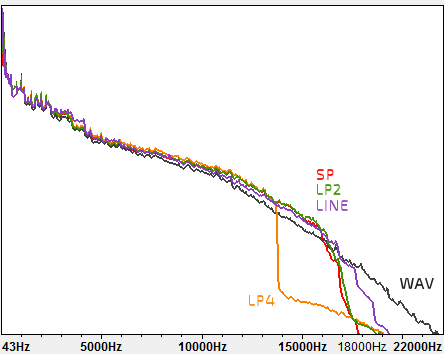Technology
MiniDisc Frequency Analysis
I’m not late to the MiniDisc party, I was a supporter from the early days. I fell out of love with the format when I bought a Rio Karma, a 20GB HDD-based player that was far more convenient than MD on account of the massive storage and the ease of file transfer. MiniDisc, when I was still an active user, required real-time recording via audio cables. It took forever, and titling the tracks had to be done on the recording device using a tiny interface with tiny buttons, and when I lost my player in the 2011 floods I never bothered to replace it.
Little did I know that my old unit was superseded by MD players with USB ports. Faster transfer, man! Good stuff! In a quest for <long story I’ll telly you later> I recently bought another MD player, a cute li’l Sony MZ-N710 NetMD. I rage against Sony’s unbelievable stupidity in this post, but for now I want to have a look at the quality of the MD recording. I have, or at least had, very good ears. 20kHz and I were well acquainted.

I always liked the sound quality of MiniDisc, though it’s entirely likely that this was a result of Sony’s solid audio circuitry as much as anything else. MD always sounded the way I wanted my stuff to sound. Whatever Sony’s ATRAC compression algorithm was throwing out in its quest for smaller files didn’t bother me.
Sony’s newer machines included Long Play modes, a way of packing more songs onto a disc by increasing the compression ratio, sort of like reducing the bit-rate of an MP3. You get smaller files, more songs on a disc, at the expense of audio quality. LP2 halved the size, allowing twice as many songs, and LP4 allowed (surprise!) four times as many. LP2, to most ears, sounded about as good as Standard Play, or SP mode. It wasn’t quite analogous to MP3 – the ATRAC compression scheme changed when LP2 and LP4 came out, so that it was, in effect, newer technology, and Sony were really, really good at their jobs, so sure, LP2 could sound as good as SP, why not?
Anyway, after reading some very old MD forums it seemed that Sony was playing some tricks, so that audio transferred from a computer in SP mode wouldn’t sound as good as audio recorded directly on the device via the line inputs in SP mode. Specifically, they say that the SP transfer is an LP2 signal ‘padded’ somehow to take the same amount of space and play back on older SP-only players, but not sound any better than LP2. Sounds unlikely to me, but whatever.
So I had a look.
My setup was simple: transfer the same song via USB to the N710, in SP, LP2 and LP4 modes, then record it with the line input, then record all four back onto the PC and compare the frequency range with the original WAV file. There are flaws with this methodology. The original WAV comparison doesn’t go out and back in via the PC’s audio circuits, for one thing, but also the volumes, especially with the line input which recorded lower than the digital transfers. The volume probably isn’t as important: I’m not as concerned with how loud the signal is, as much as how much of the signal is still there.

The short version is: SP recorded via line-in, and SP and LP2 via USB all seem about the same. There’s a small boost in the line-in recording, but we’re talking like five percent, which seems well within the margin of error for my laughably amateur science project. And so I’m probably going to stick with LP2 in order to maximize the amount of audio packed onto a disc. Update: I did no such thing. It’s one thing to match the numbers and produce the same frequencies, but it did not, in any way, sound as good.
There are a few things of note in the chart. The original WAV shoots right up to 22kHz, but the MDs die out around 19kHz, which I sort of expected. LP4 cuts out very early, but then keeps some of the high frequencies at a much lower volume, from about 14kHz to the 19kHz peak. Weirdly the USB-SP signal flatlined a whole kHz before LP2, LP4 or the line SP recordings. Again, margin of error, but still it’s a weird outlier.
Caveats: I adjusted the signals for volume since the line-in signal was about 20% lower overall, and had a weird dip at one point. I don’t consider this terribly important since the volume wasn’t what I wanted to know, and a 10% dip for small kHz band doesn’t seem relevant to this experiment. Also I should point out I don’t know what I’m doing. You don’t like my science you can do it yourself.
--NFG
[ Jul 29 2015 ]
| Next Post | Navigation | Previous Post |
|---|
Comments
Name:
Email:
Website:



Harsha
Apr 5 2022